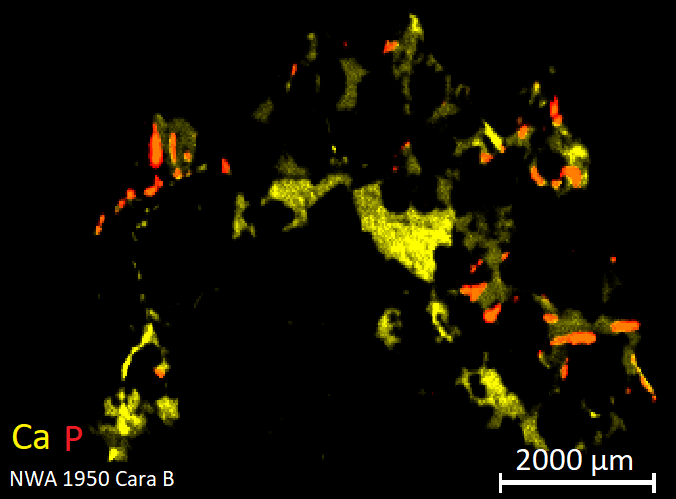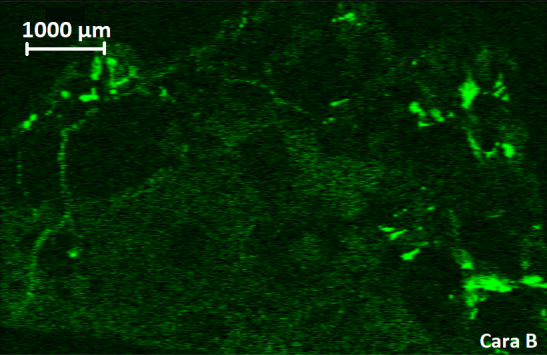Characterization of original and altered mineral phases of the Martian shergottite NWA1950 by means of non-destructive analytical techniques. Implications for the analyses of future returned samples from Mars
- University of the Basque Country, Faculty of Science and Technology, Department of Analytical Chemistry, Leioa, Spain (juanmanuel.madariaga@ehu.eus)
Introduction
The recently landed Perseverance rover from the Mars2020 mission is the first rover to select samples with the future objective of taking them back to the Earth in the Mars Sample Return future mission. Until then, Martian meteorites are still the only samples that we have on Earth to study the composition and formation of Mars. Due to the scarce abundance and the importance of these samples, the development of non-destructive characterization methodologies is of great importance. In this case, the Martian Shergottite NWA1950, considered one of the less studied Martian meteorites, has been selected with the double objective of performing the characterization of its original and altered minerals and of contributing to ascertain the degradation reactions.
Experimental
Instead of using the classical methods of analysis, a non-destructive analytical methodology that make use of spectroscopic techniques has been used. This approach could also be employed to study other meteorites or even in the future returned samples from Mars. The analytical methodology proposed is mainly based on the effectiveness of Raman microscopy for the molecular characterization, assisted by Energy Dispersive X-Ray Fluorescence (ED-XRF) and Scanning Electron Microscopy with Energy Dispersive Spectroscopy (SEM-EDS) to clarify the distribution of elements in the sample. In addition, Raman microscopy and µ-ED-XRF imaging analyses also allows performing the characterization of the whole surface of the meteorite obtaining the molecular and elemental distributions maps respectively.
Results and Discussion
The applied methodology on the NWA1950 sample showed a main matrix composed of pyroxenes and olivines. The identification of pyroxenes showed the presence of both, ortopyroxenes (low in Ca) and clinopyroxenes (high in Ca). Different olivines with different proportions of fayalite (Fe2SiO4):forsterite (Mg2SiO4) were detected by Raman, specifically olivines varying from 63 to 77% of Mg content. The study of the olivines also showed different degradations on them. The most common degradation suffered by the olivines was the oxidation of part of the iron(II) resulting in the identification of hematite (Fe2O3) grains over olivines enriched in Mg content due to the partial Fe loss after its oxidation. In other cases, the oxidation of the iron present in the olivine lead to the formation of magnetite (Fe3O4). Both reactions should lead also to the formation of silica (SiO2) and this study has identified vitreous silica by Raman spectroscopy in the olivines with less than 69% Forsterire. This observation may indicate the initial oxidation of the olivine occurred on Mars and therefore the quartz was transformed into vitreous silica due to the high temperatures and pressures suffered by the meteorite after the shock.
Among the minor compounds, it is important to highlight the presence of ilmenite (FeTiO3). In this case, the Raman bands obtained for ilmenite are shifted to higher wavenumbers than the theoretical ones. This may be indicative of a shocked Ilmenite, subjected to the high pressures of the ejection, and therefore indicating its possible Martian origin. In addition, Ilmenite can be oxidized into TiO2 that can appear as different polymorphs, rutile and anatase mainly. In this case, the identified polymorph was anatase that is formed at low temperatures, indicating that anatase is not an alteration compound from Mars but rather a terrestrial alteration mineral formed after the oxidation of ilmenite once the meteorite was on Earth.
Merrillite (Ca9NaMg(PO4)7) was also detected as an important mineral phase in this meteorite. The elemental calcium and phosphorous ED-XRF distributions can be appreciated in Figure 1, showing the overlap between these two elements, matching perfectly with the molecular Raman distribution of merrillite in one of the faces of the meteorite.


Figure 1. ED-XRF elemental distribution maps of Ca and P, showing in orange the overlaping of both elements (top) and the Raman image showing the molecular distribution of merrillite (down).
Iron chromites (FeCr2O4) were also detected, by means of Raman and SEM-EDS microscopic techniques, as abundant particles distributed all along the surface of the meteorite by means of Raman and SEM-EDS.
Two different calcites were identified by Raman microscopy. One of them is due to the presence of terrestrial calcite with its main characteristic band at 1086 cm-1. However, most were shocked calcites due to the shift of the main Raman band to higher wavenumbers (to 1088 and even to 1089 cm-1), suggesting again the effect of the pressure that suffered the meteorite and thus showing the Martian origin of these shocked calcites. The non-shocked calcites should be considered as terrestrial weathering compounds.
Finally, some sulfides were identified as chalcocite (Cu2S) and acanthite (β-Ag2S) by means of Raman and SEM-EDS microscopy. The origin of acanthite cannot be confirmed as Martian because if argentite (α-Ag2S), the high temperature stable phase of silver sulfide, was formed during the harsh conditions that suffered the meteorite during its ejection from Mars, the formation of argentite is reversible when the pressure ceases, and after the entrance in Earth atmosphere, the acanthite will be formed again.
Conclusions
As can be seen, the employed analytical methodology allowed us to characterize the original Martian mineral composition of the meteorite as well as the presence of alterations minerals originated in Mars but also after terrestrial weathering processes. In none of the analyses the sample was manipulated or treated chemically nor physically, all the measurements were performed over the surface of a thin section of the meteorite. Therefore, the same non-destructive analytical methodology could be followed for the characterization of other meteorites from other origins and also for the Mars samples when they are back on the Earth as first non-destructive characterization step that can lead to much information.
How to cite: Madariaga, J. M., Coloma, L., García-Florentino, C., Huidobro, J., Torre-Fdez, I., Aramendia, J., Castro, K., and Arana, G.: Characterization of original and altered mineral phases of the Martian shergottite NWA1950 by means of non-destructive analytical techniques. Implications for the analyses of future returned samples from Mars, Europlanet Science Congress 2021, online, 13–24 Sep 2021, EPSC2021-645, https://doi.org/10.5194/epsc2021-645, 2021.

